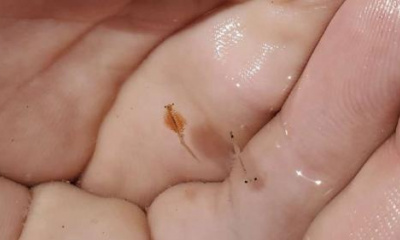SALT LAKE CITY — Utah became the first landlocked state to designate a state crustacean this year: the upside-down swimming, 22-legged, beady-eyed, magnificently funky little brine shrimp.
Despite fluctuation in water and salinity levels over time in the Great Salt Lake, along with the accumulation of contaminants, these little creatures have persisted by the millions as the lake's unofficial mascot.
But the bounds of the brine shrimp's resilience extend even beyond the aquatic. Should drought and the diversion of rivers ever shrink the shorelines of Great Salt Lake to the point of disappearing, it would not necessarily spell the end for the brine shrimp. In the absence of water, there would be countless tiny shrimp eggs left behind, blowing in the whirlwinds with the lakebed dust. And those eggs have some remarkable biological abilities.
When brine shrimp eggs (referred to as cysts) are dehydrated or exposed to conditions that won't support life, they enter a science fiction-like state of suspended animation called quiescence. In this state, metabolism is practically at a standstill. Meanwhile, the brine shrimp eggs can withstand extreme ranges of temperature and salinity, oxygen deprivation, and other harsh conditions. And, then, if returned to normal conditions, years or even decades later, the embryos will continue development and baby brine shrimp quickly emerge from their crustacean time capsules.
The extremes of this ability have been seen by Wayne Wurtsbaugh, who is now an emeritus professor in the Watershed Sciences Department and the Ecology Center at Utah State University. Using Great Salt Lake sediment core samples, he collected brine shrimp eggs from different depths below the lake bed, which correspond to different time points in the past.
Buried several inches in the sediment and deprived of oxygen, Wurtsbaugh thought the eggs might be in the state of quiescence. His student at the time, Erin Fleming Jones, then returned the eggs to warm saltwater to see if they would hatch.
"We expected some hatching, at least in the upper sediments, as we knew that they are extremely resistant," Wurtsbaugh recalls. "However, we were really surprised that some hatched that were over 200 years old."
That means brine shrimp in the lab at Utah State University were the direct offspring of shrimp that swam in Great Salt Lake long before it had a city named after it.
Brine shrimp aren't the only crustaceans that can do this. If you've ever been hiking along the red rocks in southern Utah during warmer months and come across what might look like larger brine shrimp or trilobites scuttling about in temporary pools of water, then you've probably seen fairy shrimp or tadpole shrimp — both distant cousins of the brine shrimp, with similar abilities.
Decades of research has found this shrimp superpower stems from three major factors working in unison.
First, the embryos are protected by a rigid and mostly impermeable outer shell, which looks like a partially deflated ball under a microscope. Second, harsh conditions activate a set of special stress response proteins in the embryo that function in preventing cell parts from deteriorating. And third, dehydrated eggs are known to be loaded with a sugar called trehalose. It appears that trehalose can mimic water molecules and preserve proteins, lipids and other important biomolecules by "freezing" them in a dehydrated crystalline state. And when the eggs return to warm saltwater and development continues, the shrimp embryos can use that same trehalose as an energy source for growth.
Trehalose has caught the attention of food and pharmaceutical industries in recent years. Because it is nontoxic and can stabilize such a wide range of important biomolecules, it is used to help preserve some food products and pharmaceuticals during dehydration and freezing.
Brine shrimp mascot
Brine shrimp have been in the Great Salt Lake area for thousands of years and will probably be there for thousands of years to come — even if the lake dries up for a long period. Unfortunately, not everything in the lake's ecosystem is as perennial as the brine shrimp are. That includes the 338 species of birds that rely on the lake, some of which feed on brine shrimp.
And of course, there are also the 2 million humans that live along the Wasatch Front and depend on the Great Salt Lake to keep the air free of contaminated dust. So as the new state crustacean, perhaps there is no better ambassador than the brine shrimp to inspire us humans to play the long game and strive for adaptability and resilience — in our communities, and in how we can manage water to ensure that those communities stay healthy and thriving for decades to come.








